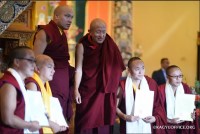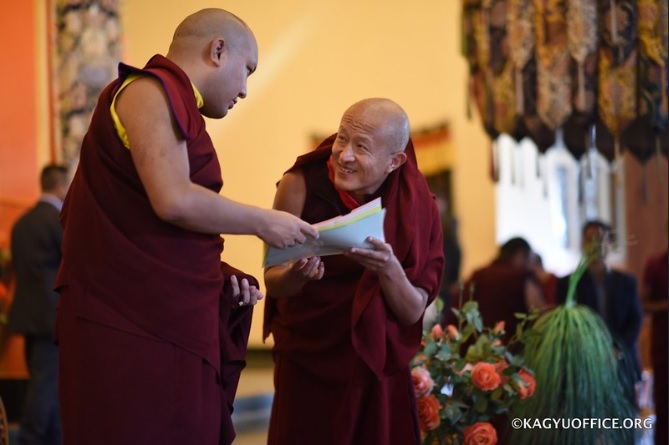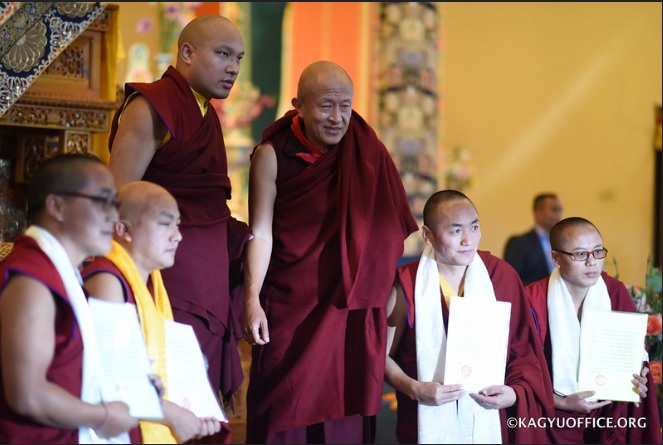法王新闻 | 2016年11月
於印度宗薩佛學院頒發堪布證書
Awards Khenpo Certificates at Dzongsar Khyentse Chökyi Lodrö Institute
རྫོང་སར་བཤད་གྲྭ་ཆོས་ཀྱི་བློ་གྲོས་ལ་སྩལ་བའི་བཀའ་སློབ།

時間:2016年11月20日 November 20, 2016
地點:印度 喜馬偕爾邦 炯達拉 Chauntra, HP, India
On this auspicious day of the Buddha’s Decent from the Realm of Tushita, which is one of the four major Buddhist holidays, the Gyalwang Karmapa traveled in the morning to Dzongsar Khyentse Chökyi Lodrö Institute to give diplomas to four new khenpos (professors and future abbots). Usually the head of the lineage performs this ceremony; however, to signify the close relationship between the Karmapa and Khyentse lineages, Dzongsar Khyentse Rinpoche kindly invited the Karmapa to take this role.
在佛教四大節日之一的天降日,法王上午前往宗薩欽哲確吉羅卓佛學院,為四位新堪布(佛學教授或未來的住持)頒發學位證書。通常堪布學位的頒發典禮是由傳承領袖主持,然而為表徵噶瑪巴傳承和欽哲傳承的密切關係,宗薩欽哲仁波切特別邀請法王擔任這項殊榮。
For this special occasion, the wide path from the main gate of the Institute to the shrine hall was decorated with the traditional eight auspicious symbols, made of crushed stones in brilliant colors and lined on either side by a double row of marigolds.
Walking down this path under a golden umbrella, the Karmapa entered the spacious shrine hall, which was filled with monks and lay practitioners from all parts of the globe. Students from the nearby Suja and Sambhota TCV Schools were also present.
為此盛會,從宗薩佛學院大門通往大佛殿的道路兩旁飾有雙排萬壽菊,路面上有以礦粉彩繪的八吉祥。在黃金傘蓋的護導下,法王進入大殿。殿中坐滿來自世界各地的僧俗二眾,鄰近西藏兒童村蘇嘉(Suja)和桑布達(Sambhota)分校的學生也在場觀禮。
Once the Karmapa was seated on an elegant throne before a tall, radiant Buddha, Dzongsar Khyentse Rinpoche gave the traditional mandala offering along with the representations of body, speech and mind, followed by a long golden scarf. Rice and tea were served to everyone while the monks chanted the practice of the Sixteen Arhats, who are entrusted with preserving the teachings.
法王在佛像前的莊嚴法座上安坐後,宗薩欽哲仁波切向法王行傳統的曼達拉和身語意供養,並獻上一條長長的金黃色哈達。在僧眾修持十六羅漢的念誦聲中,會眾受到吉祥飯和奶茶的招待。
His Holiness started his talk with thanks to Khyapje Dzongsar Khyentse Rinpoche for inviting him and recalled: “When I was still in Tibet, of all the collected works I read, the one I Looked at the most was that of the first Khyentse, Jamyang Khyentse Wangpo (Pema Ösel Dongak Lingpa). I read it cover to cover and returned to it many times.”
致詞中,法王首先感謝怙主宗薩欽哲仁波切的盛情邀請:「當我還在西藏時,我所讀過的所有合集中,讀得最多的就是第一世欽哲仁波切蔣揚欽哲旺波(Jamyang Khyentse Wangpo)的著作。我把它從頭讀到尾,之後還多次溫習。」
Khyentse Wangpo was truly rime (nonsectarian), the Karmapa stated. “These days saying ‘rime’ sounds good but often it is just ornamental, merely for show,” the Karmapa remarked. “To be a true master of these teachings is not at all easy. Many people are said to be experts, but if you look through history for a master of the teachings, you will find that Jamyang Khyentse Wangpo was an authentic one.”
法王指出,欽哲旺波是真正的利美(無教派分別)的大師:「近來『利美』說得很好聽,但往往流於只是裝飾,不過是做秀,要真正成為這些法教的大師可一點都不容易。許多人被說成是專家,但如果你縱橫古今的歷史去找,你會發現蔣揚欽哲旺波是一位正宗的利美大師。」
Stating that “the rime teachings were important for cultivating a pure and encompassing outlook,” the Karmapa spoke warmly of the relationship between Jamgon Kongtrul Lodro Thaye and Jamyang Khyentse Wangpo: “In the predictions of the 5th Karmapa Deshin Shekpa (1384-1415), the coming of the Khyentse and Kongtrul incarnations was foretold, and Deshin Shekpa also prophesized that whoever made a connection with them would find it deeply meaningful.”
法王表示:「利美法教對於培養清淨和包容的視見極為重要。」法王動容地提到蔣貢康楚羅卓泰耶和蔣揚欽哲旺波的關係:「第五世噶瑪巴德新謝巴(1384-1415)曾授記欽哲和康楚轉世傳承的出現,他預言:任何與他們結緣的人,都會感到這份因緣的意義深重。」
The Karmapa also commented, “Jamgon Kongtrul Lodro Thaye’s Five Great Treasuries were mainly requested by Khyentse Wangpo, who also gave him encouragement and support, so Khyentse Wangpo deserves a lot of credit, which is clear when you read the life story of Jamgon Kongtrul Lodro Thaye.”
法王同時提到:「如果你讀過蔣貢康楚羅卓泰耶的傳記,你會清楚知道,蔣貢康楚羅卓泰耶著作《五寶藏》主要是因為欽哲旺波之請。欽哲旺波同時給予他鼓勵和支持,因此欽哲旺波的功勞很大。」
Continuing to speak of their inter-relationships, His Holiness remarked, “The Karmapa and Jamgon Kongtrul Lodro Thaye had a connection, a Dharma samaya, so close that they were almost one person with the same heart. Something similar can be said about the connection between the Karmapa and Jamyang Khyentse Wangpo—they were like one being in whom beat the same heart.”
法王繼續說明他們之間的關連:「噶瑪巴和蔣貢康楚羅卓泰耶是有關連的,他們在法上的三昧耶的親近關係就像是有著同一顆心的同一個人。而噶瑪巴和蔣揚欽哲旺波可以說也有類似的關係,他們就像是有著同樣心跳的同一個人。」
His Holiness praised the present Khyentse Rinpoche’s way of giving advice, which the Karmapa described as “unambiguous, straight forward, penetrating, practical, and touching the heart.” Therefore, the Karmapa said, “I have true devotion and pure vision for this lineage. I am very happy that I could meet Khyapje Dzongsar Khyentse Rinpoche here at his seat with all the khenpos and students, and that I could be present with everyone in a single mandala.”
法王讚揚這世欽哲仁波切的教誨方式是:「清楚明白、直截了當、透徹入骨、切合實際、觸動人心。」因此,法王表示:「我對這個傳承具有真誠的虔敬和淨觀。我非常高興在怙主宗薩欽哲仁波切的法座與他及其眾弟子相會,並且與在場所有的堪布和學生同處一個壇城。」
His Holiness continued to explain that the Karmapas also have a close relationship with the Sakya lineage in general. The 6th Karmapa, Thongwa Donden (1416-1453), received teachings on the sutras from the great Sakya master Kunkhyen Rangton Chenpo, who in turn said about the Karmapa, “I have a student who is an emanation of the Buddha.” Karma Trinleypa Chenpo, who held both Sakya and Kagyu lineages, was a student of the 7th Karmapa and a teacher of the 8th. So it is clear that the commentarial lineage in the Karma Kamtsang has roots in the Sakya tradition.
接著,法王解釋,一般而言,歷代噶瑪巴與薩迦傳承也有密切的關係。第六世噶瑪巴通瓦敦殿(1416-1453)從薩迦派大師袞謙讓敦千波(Kunkhyen Rangton Chenpo)領受經教,大師這麼描述噶瑪巴:「我有一位學生是佛陀的化身。」而噶瑪欽列巴千波大師(Karma Trinleypa Chenpo)同時是薩迦和噶舉法教的傳承持有者,他是第七世噶瑪巴的弟子,同時是第八世噶瑪巴的老師。因此,噶瑪岡倉的釋論傳承有其在薩迦傳統的根基。
In general, the Karmapa remarked, these days we have available to us most of the outer and inner positive conditions, and the negative ones are few and far between. If we are able to muster our abilities and take advantage of these, then everything needed is present. To engage in studies and bring them to their fullest measure is extremely important he said.
法王指出,總的來說,現今我們的逆緣稀少,可以取得的內外順緣最多。如果我們能夠匯集自己的力量,善用這些資源,那麼我們的一切所需就都有了。因此,我們不僅要專注於修學,而且我們的修學還要達到登峰造極之境,這點非常重要。
Turning to the way of studying, the Karmapa affirmed, “It is important to maintain our Tibetan traditions. Since we live in the 21st century, however, Tibetans should not just follow their own tradition, but also look into the way things are done in this present age. In particular, we should pay attention to how education is given and include history in our curriculum. “For example, we might study [Chandrakirti’s] Entering the Middle Way for a year,” he stated, “but if asked who translated this root text into Tibetan, we cannot answer because we have not looked into the historical background. This needs to change.”
在談到修學的方式時,法王強調:「維護我們的西藏傳統很重要。然而,我們生活在21世紀,藏人不能只遵循自己的傳統,也要研究現代做事的方法。尤其,我們應該注重教育的方式,並且把歷史放進教程內。例如,我們可能學了一年[月稱論師]的《入中論》,但如果有人問我們:『它的根本偈是由誰翻譯為藏文的?』我們就回答不出來了,因為沒有研究它的歷史背景。因此,這需要改變。」
“If we know about the generations stretching into the distant past,’ the Karmapa explained, ‘when we are looking at a text, a different perspective and feeling can happen. On the other hand, if we are not aware of the history and look straight off at the text, we will not know about the scholars who wrote it, or when and where they lived. We will just know their name, but not the relationships they had with other masters and what their life’s situation was. Without this knowledge, our understanding of a text is not complete. In Tibet, the way of learning traditions was outstanding, and yet, we also need to learn and take an interest in the contemporary ways of doing research and studying.”
「然而,如果從過去許多世代以降的歷史我們都知道,那麼在讀一部經時,我們可能就會有不同的觀點和感受。如果不知道它的歷史背景就直接讀這部經,我們就不會知道這部經的作者是個什麼樣的人,也不會瞭解他所生活的時代和環境。我們只是知道作者的名字,但不知道他與其他的大師有什麼關係,以及他們生活的情況。沒有這方面的知識,我們對這部經的認識就不完全。在西藏,我們有殊勝的學習傳統。然而,我們也要學習並感興趣於當代做研究和讀書方式。」
The Karmapa remarked that in continuing the rime tradition of the Khyentse incarnations, the Dzongsar Institute does not follow one particular lineage but welcomes students from all different traditions and so it has a wide-ranging influence.
法王表示,秉持著欽哲傳承的利美傳統,宗薩佛學院不只是遵循某一特定的傳承,而是歡迎所有不同傳承的學生,因此,它的影響力極為廣大。

The Karmapa concluded with saying how fortunate he felt to have come and thanked everyone, especially Khyapje Dzongsar Khyentse Rinpoche, for whom he made the aspiration prayer that his activities flourish and spread widely. For his students in the monastic college, the Karmapa prayed that their minds be in harmony and their discipline be pure, and that they spend all their time in the Dharma activity of study and practice.
結語中,法王表示,他感到非常幸運能夠來到這裡,感謝在場的每一個人,尤其是怙主宗薩欽哲仁波切,他祈願仁波切的佛行事業興盛弘展,祈願佛學院裡的學生心意和合、戒律清淨,所有時間都投注於佛法的學習和修持。
After awarding diplomas to the four new khenpos, the Karmapa had lunch at the Institute and then left with Dzongsar Khyentse Rinpoche for the Bir Tibetan Colony.
在為四位新堪布頒發學位證書後,法王在佛學院內用午餐。之後,法王與宗薩欽哲仁波切一起啟程前往比爾藏人村。
网页修改记录:2022年10月05日,此处新建中英网页,放YOUTUBE视频链接;2024年3月22日,放置剪辑音频和小视频。
Youtube 视频
